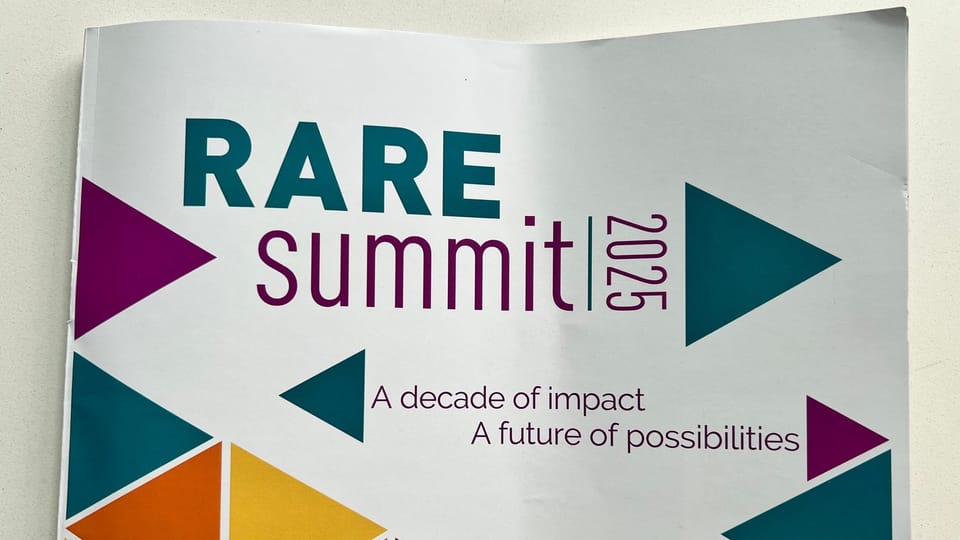RareSummit 25

This was my first RareSummit, and my first visit to the Wellcome Genome Center. My visit started with the familiar mix of anticipation and curiosity. Rare disease events always draw together a unique blend of energy: determination, vulnerability, scientific rigour, and a palpable sense that everyone in the room understands something the wider world often misses. It was a packed day, these were my highlights and Key thoughts:
“Ten Moments” and Ten Years of Change
The day opened with Jo Balfour, CamRARE’s Managing Director, sharing ten moments of impact in CamRARE’s history—an invitation to see how connections made in rooms like this ripple outward into research, policy, and even clinical trials. One example that stuck with me was how Andy Kulina networked his way from the RareSummit 23 to a clinical trial for Phelan-McDermid Syndrome, a rare disease which affects his daughter.
Key thought: Exercise that ‘Networking’ muscle! Anyone can do it, and networking gets things done!
Andy Kulina networked his way from the RareSummit 23 to a clinical trial
Rare Disease Through the Lens of Human Rights
I recognised Dr Lucy McKay immediately, or rather, I recognised her voice. She is the CEO of Medics for Rare Disease, “a registered charity driving an attitude change towards rare diseases among medical students and doctors in training.”. Lucy presents their podcast, a key part of my training soundtrack this summer.
Dr McKay’s session challenged us to consider rare disease not as a niche biomedical subset but as a human rights issue. Her words resonated strongly “If you’re not in the rare disease world, you don’t know it exists.” And “No one here is asking for anything more than for their human rights to be met.”
This reframing felt powerful. Many “workarounds” in rare disease aren’t innovations—they’re coping mechanisms for systems that don’t yet protect our rights. The question she posed stayed with me:
Key thought: “Are we filling a gap, or finding a workaround for rights not yet recognised?”

Mental Wellbeing: Meeting People Where They Are
The afternoon sessions looked at mental wellbeing and living with rare disease. These were perhaps the most important conversations of the day. The speakers articulated several things which I often see in the PKU and brain injury communities:
- Sometimes living with the rarity is the hardest part.
- Counsellors don’t need to be experts in the condition to support us, they just need to meet us where we are.
- We assume people will advocate for themselves, but many are simply overwhelmed.
- Emotional support at diagnosis shouldn’t be a luxury; it should be standard care.
Key thought: Miscommunication happens not just between patient and clinician, but between advocates, educators, researchers, and families too.
Buy me a cuppa ☕ — your support helps keep this blog free, and helps to me write about PKU, brain injury & mental health.
Closing Thoughts: The Next Decade
The closing panel on the next decade of rare disease innovation was hopeful, ambitious, and—importantly—honest. A few numbers jumped out at me:
- 3,000 ongoing studies, with rare disease second only to oncology.
- By 2035, half of all treatments are expected to be informed by genomics.
- 52% of new rare disease medicines are available in England, well below Germany’s 89%. A large gap and a massive opportunity.
The day ended with this reminder from Emma Green, Chair of Trustees at CamRARE:
Key thought: “All of us branching off into our own rare spaces is not going to advance this. When you have an opportunity to raise your voice, please use it.”
What I’m Taking Away
RARESummit25 was a long, motivating and tiring day. I left with:
- A stronger belief in patient-led research
- A renewed sense of urgency around mental health support
- Practical ideas for my future advocacy
- Encouragement to keep showing up—and keep using my voice
The speakers and guests I spoke with during the day gifted me with a sense of connection with a wider rare disease ecosystem; to a creative space, full of determined, hopeful people. Mostly, I left feeling less “rare” and more at home.
Because in that room, surrounded by people working to make rare lives visible, valued, and connected, I felt part of something bigger—something determined, collaborative, and deeply human.
“If you’re not in the rare disease world, you don’t know it exists.”

Member discussion